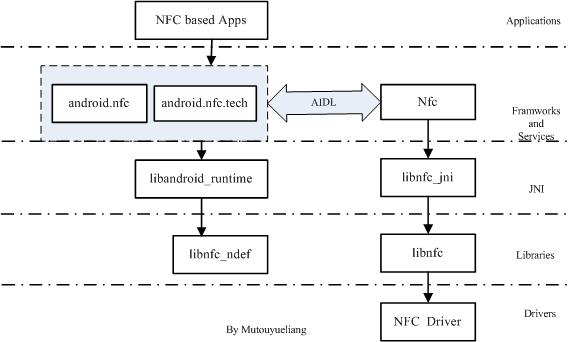android 5.0 NFC支持
2016-02-22 10:52
375 查看
1. Near Field Communications (NFC)
Android 2.3 includes an NFC stack and framework API that lets developers read NDEF tags that are discovered as a user touches an NFC-enabled device to tag elements embedded
in stickers, smart posters, and even other devices.
The platform provides the underlying NFC services that work with the device hardware to discover tags when they come into range. On discovering a tag, the platform notifies
applications by broadcasting an Intent, appending the tag's NDEF messages to the Intent as extras. Applications can create Intent filters to recognize and handle targeted tags and messages. For example, after receiving a tag by Intent, applications extract
the NDEF messages, store them, alert the user, or handle them in other ways.
The NFC API is available in the
from
NFC communication relies on wireless technology in the device hardware, so support for the platform's NFC features on specific devices is determined by their manufacturers.
To determine the NFC support on the current device, applications can call
To use the NFC API, applications must request permission from the user by declaring
Additionally, developers can request filtering on Android Market, such that their applications are not discoverable to users whose devices do not support NFC. To request filtering, add
NFC的应用场景有很多,但Android 2.3目前API只提供了电子标签阅读器的功能。相信随着Android的版本升级,后续会增加很多应用场景和API。
功能是少一点,但从无到有的第一步总是不容易的。从架构上看,至少有以下几部分的改动:
Android Framework层,为应用开发增加了相关API(即英文中的framework API)。
协议层,增加NFC的协议栈(即英文中的NFC Stack)。
硬件适配层,为硬件生产商提供适配接口,此层应该与NFC硬件的Linux驱动通讯(实现方式待验证)。
工作流程是当支持NFC功能的手机或其他电子终端(后面简称手机)在用户开启NFC功能的时候,如果手机内置的NFC扫描器(相当于类NfcAdapter的功能)扫描到电子标签后,就会向相关用户程序发送ACTION_TAG_DISCOVERED的Intent,Itent的extras架构中会包含NDEF(NFC Data Exchange Format)消息。如何处理此NDEF消息,就是用户程序的事情了。
NFC的API在android.nfc的包中提供,这个包主要提供三个大类,其中:NfcAdapter描述的就是手机中的NFC硬件,Android 2.3中可以暂时理解为电子标签扫描器。电子标签和扫描器中的消息通过NdefMessage来表示,这个类很简单,只是封装了NdefRecord。每个NdefMessage中可以包含多个NdefRecord,通过类NdefMessage的方法getRecords()可以查询到消息的所有NdefRecord。NdefRecord才是信息的真正载体,正确理解这个类是理解NFC技术的一个重点。NFC的技术规范http://www.nfc-forum.org/specs/spec_list/是理解这个类不可或缺的资料。
应用程序的编程思路是:
通过android.nfc.NfcAdapter.getDefaultAdapter()取得手机的objNfcAdapter
通过objNfcAdapter.isEnabled()查询该手机是否支持NFC
如果手机支持NFC,就申请接收
如果接收到
2.Android中对NFC的实现代码分布在如下几个地方:
./frameworks/base/core/java/android/nfc/ -实现了NFC的应用接口
./external/libnfc-nci -HAL shared libary
./external/libnfc-nxp -是用C语言编写的函数库,编译生成libnfc和libnfc_ndef两个函数库。libnfc 是一个主要的库,实现了NFC
Stack的大部分功能,主要供NFC的服务进程调用。libnfc_ndef是一个很小的函数库,主要是实现NDEF消息的解析,供Framework 调用。
./packages/apps/nfc - 是一个类似于电话本的应用程序,但这个程序在手机开机后自动启动,一直运行,是作为NFC的服务进程存在的。是NFC架构中的核心。
图示如下:

附录:
NFC Service的说明
NFC: Move NFC service implementation out of system_server.
NFC service is now an application service in packages/apps/Nfc.
NFC service is registered through ServiceManager.addService(), and the proxy
object NfcAdapter obtains a handle to it through ServiceManager.getService().
**Important** Had to add new symbols AID_NFC / NFC_UID / android.uid.nfc and
modify service_manager.c, Process.java and PackageManagerService.java in order
to force the com.android.nfc process to take a fixed uid, so that it can use
ServiceManager.addService().
Most of the JNI has moved to packages/apps/Nfc/jni. However NdefRecord and
NdefMessage require some in-process native code, so android_com_NdefMessage.cpp
and android_com_NdefRecord.cpp stay in frameworks/base/core/jni. They link to
a very small library libnfc_ndef.so that implements NDEF message parsing. This
has been added to core.mk so all devices (even without NFC hardware) can work
with NDEF data.
Android 2.3 includes an NFC stack and framework API that lets developers read NDEF tags that are discovered as a user touches an NFC-enabled device to tag elements embedded
in stickers, smart posters, and even other devices.
The platform provides the underlying NFC services that work with the device hardware to discover tags when they come into range. On discovering a tag, the platform notifies
applications by broadcasting an Intent, appending the tag's NDEF messages to the Intent as extras. Applications can create Intent filters to recognize and handle targeted tags and messages. For example, after receiving a tag by Intent, applications extract
the NDEF messages, store them, alert the user, or handle them in other ways.
The NFC API is available in the
android.nfcpackage. The key classes are:
NfcAdapter, which represents the NFC hardware on the device.
NdefMessage, which represents an NDEF data message, the standard format in which "records" carrying data are transmitted between devices and tags. Applications can receive these messages
from
ACTION_TAG_DISCOVEREDIntents.
NdefRecord, delivered in an
NdefMessage, which describes the type of data being shared and carries the data itself.
NFC communication relies on wireless technology in the device hardware, so support for the platform's NFC features on specific devices is determined by their manufacturers.
To determine the NFC support on the current device, applications can call
isEnabled()to query the
NfcAdapter. The NFC API is always present, however, regardless of underlying hardware support.
To use the NFC API, applications must request permission from the user by declaring
<uses-permission android:name="android.permission.NFC">in their manifest files.
Additionally, developers can request filtering on Android Market, such that their applications are not discoverable to users whose devices do not support NFC. To request filtering, add
<uses-feature android:name="android.hardware.nfc" android:required="true">to the application's manifest.
NFC的应用场景有很多,但Android 2.3目前API只提供了电子标签阅读器的功能。相信随着Android的版本升级,后续会增加很多应用场景和API。
功能是少一点,但从无到有的第一步总是不容易的。从架构上看,至少有以下几部分的改动:
Android Framework层,为应用开发增加了相关API(即英文中的framework API)。
协议层,增加NFC的协议栈(即英文中的NFC Stack)。
硬件适配层,为硬件生产商提供适配接口,此层应该与NFC硬件的Linux驱动通讯(实现方式待验证)。
工作流程是当支持NFC功能的手机或其他电子终端(后面简称手机)在用户开启NFC功能的时候,如果手机内置的NFC扫描器(相当于类NfcAdapter的功能)扫描到电子标签后,就会向相关用户程序发送ACTION_TAG_DISCOVERED的Intent,Itent的extras架构中会包含NDEF(NFC Data Exchange Format)消息。如何处理此NDEF消息,就是用户程序的事情了。
NFC的API在android.nfc的包中提供,这个包主要提供三个大类,其中:NfcAdapter描述的就是手机中的NFC硬件,Android 2.3中可以暂时理解为电子标签扫描器。电子标签和扫描器中的消息通过NdefMessage来表示,这个类很简单,只是封装了NdefRecord。每个NdefMessage中可以包含多个NdefRecord,通过类NdefMessage的方法getRecords()可以查询到消息的所有NdefRecord。NdefRecord才是信息的真正载体,正确理解这个类是理解NFC技术的一个重点。NFC的技术规范http://www.nfc-forum.org/specs/spec_list/是理解这个类不可或缺的资料。
应用程序的编程思路是:
通过android.nfc.NfcAdapter.getDefaultAdapter()取得手机的objNfcAdapter
通过objNfcAdapter.isEnabled()查询该手机是否支持NFC
如果手机支持NFC,就申请接收
ACTION_TAG_DISCOVERED的Intent
如果接收到
ACTION_TAG_DISCOVERED,就提取NdefMessage,并在此基础上进而提取NdefRecord,整个是一个消息解析过程
2.Android中对NFC的实现代码分布在如下几个地方:
./frameworks/base/core/java/android/nfc/ -实现了NFC的应用接口
./external/libnfc-nci -HAL shared libary
./external/libnfc-nxp -是用C语言编写的函数库,编译生成libnfc和libnfc_ndef两个函数库。libnfc 是一个主要的库,实现了NFC
Stack的大部分功能,主要供NFC的服务进程调用。libnfc_ndef是一个很小的函数库,主要是实现NDEF消息的解析,供Framework 调用。
./packages/apps/nfc - 是一个类似于电话本的应用程序,但这个程序在手机开机后自动启动,一直运行,是作为NFC的服务进程存在的。是NFC架构中的核心。
图示如下:

附录:
NFC Service的说明
NFC: Move NFC service implementation out of system_server.
NFC service is now an application service in packages/apps/Nfc.
NFC service is registered through ServiceManager.addService(), and the proxy
object NfcAdapter obtains a handle to it through ServiceManager.getService().
**Important** Had to add new symbols AID_NFC / NFC_UID / android.uid.nfc and
modify service_manager.c, Process.java and PackageManagerService.java in order
to force the com.android.nfc process to take a fixed uid, so that it can use
ServiceManager.addService().
Most of the JNI has moved to packages/apps/Nfc/jni. However NdefRecord and
NdefMessage require some in-process native code, so android_com_NdefMessage.cpp
and android_com_NdefRecord.cpp stay in frameworks/base/core/jni. They link to
a very small library libnfc_ndef.so that implements NDEF message parsing. This
has been added to core.mk so all devices (even without NFC hardware) can work
with NDEF data.
相关文章推荐
- Android Studio 中 proguard-rules.pro 的模版
- 3种Android隐藏顶部状态栏及标题栏的方法
- Android中,SD卡上的媒体文件(图片、视频)的改变与通知
- Android 标题
- android刷新媒体库
- Android开发-优秀博客参考
- android中延迟执行某个任务
- Android性能优化典范
- Ubuntu android studio 创建虚拟设备问题
- Android ActionBar 创建 及动态改变
- Android中View的性命周期
- Android中用OpenGL ES Tracer分析绘制过程
- adnroid开发常用的难点记录(如 屏幕录制)
- 如何获取Android5.1 Source Code
- 瀑布流效果RecycleView+CardView
- Android模仿知乎的回答详情页的动画效果
- 【Android】ExpandableListView 默认展开和不可点击
- [Exception Android 22] - Could not find com.android.support:design:23.1.1
- Android Low Memory Killer
- Android UI效果之绘图篇(一)
